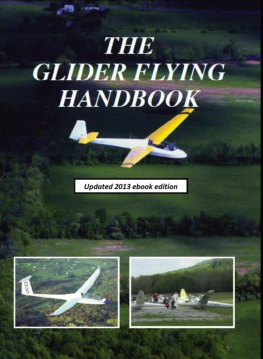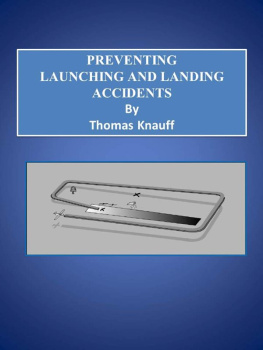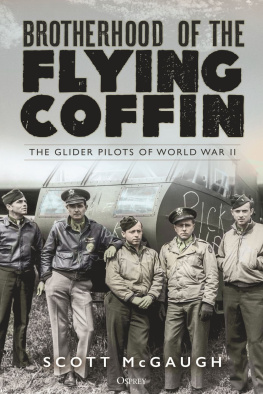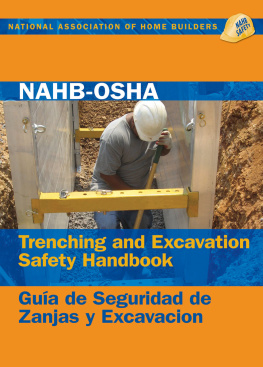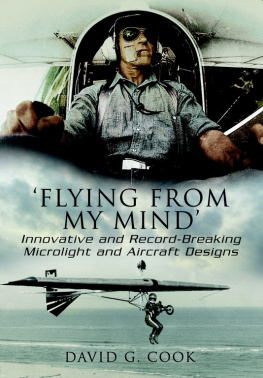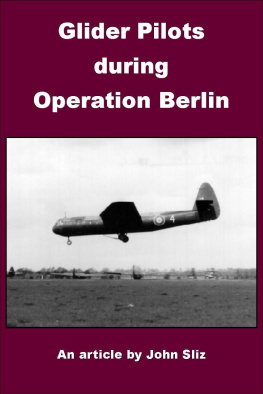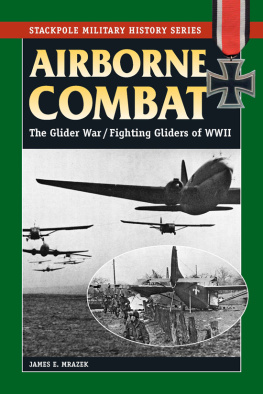Thomas Knauff - The Glider Flying Handbook
Here you can read online Thomas Knauff - The Glider Flying Handbook full text of the book (entire story) in english for free. Download pdf and epub, get meaning, cover and reviews about this ebook. year: 2012, publisher: BookBaby, genre: Children. Description of the work, (preface) as well as reviews are available. Best literature library LitArk.com created for fans of good reading and offers a wide selection of genres:
Romance novel
Science fiction
Adventure
Detective
Science
History
Home and family
Prose
Art
Politics
Computer
Non-fiction
Religion
Business
Children
Humor
Choose a favorite category and find really read worthwhile books. Enjoy immersion in the world of imagination, feel the emotions of the characters or learn something new for yourself, make an fascinating discovery.
- Book:The Glider Flying Handbook
- Author:
- Publisher:BookBaby
- Genre:
- Year:2012
- Rating:3 / 5
- Favourites:Add to favourites
- Your mark:
- 60
- 1
- 2
- 3
- 4
- 5
The Glider Flying Handbook: summary, description and annotation
We offer to read an annotation, description, summary or preface (depends on what the author of the book "The Glider Flying Handbook" wrote himself). If you haven't found the necessary information about the book — write in the comments, we will try to find it.
The Glider Flying Handbook, originally published by the FAA in 2003 has numerous errors in content - some of which can contribute to serious accidents. This corrected ebook version has more than 1,400 changes - many of which are very serious safety issues.
The Glider Flying Handbook — read online for free the complete book (whole text) full work
Below is the text of the book, divided by pages. System saving the place of the last page read, allows you to conveniently read the book "The Glider Flying Handbook" online for free, without having to search again every time where you left off. Put a bookmark, and you can go to the page where you finished reading at any time.
Font size:
Interval:
Bookmark:

U.S. DEPARTMENT OF TRANSPORTATION FEDERAL AVIATION ADMINISTRATION
Flight Standards Service
Originally published in 2003 by the FAA.
More than 1,500 editorial changes made in 2010 and 2012 to remove typographical, and content errors to comply with common standards as approved by the FAA, aviation community, the soaring community, and the Junior High School English department.
In addition to substantive errors, involving common aviation and gliding information, numerous editorial changes to correct spelling and grammatical errors were made.
Numerous photographs and drawings were changed to remove errors.
Copyright 2013
ISBN: 9781624881398
The Glider Flying Handbook is designed by the FAA as a technical manual for applicants who are preparing for glider category rating and for currently certificated glider pilots who wish to improve their knowledge.
Certificated flight instructors will find this handbook a valuable training aid, since detailed coverage of aeronautical decision making, components and systems, aerodynamics, flight instruments, performance limitations, ground operations, flight maneuvers, traffic patterns, emergencies, soaring weather, soaring techniques, and cross-country is included. Topics, such as radio navigation and communication, use of flight information publications, and regulations are available in other Federal Aviation Administration (FAA) publications.
This handbook conforms to pilot training and certification concepts established by the FAA. There are different ways of teaching, as well as performing flight procedures and maneuvers, and many variations in the explanations of aerodynamic theories and principles. This handbook adopts a selective method and concept to flying gliders. The discussion and explanations reflect commonly used practices and principles.
Occasionally, the word must or similar language is used where the desired action is deemed critical. The use of such language is not intended to add to, interpret, or relieve a duty imposed by Title 14 of the Code of Federal Regulations (14 CFR).
It is essential for persons using this handbook to also become familiar with and apply the pertinent parts of 14 CFR and the Aeronautical Information Manual (AIM). Performance standards for demonstrating competence required for pilot certification are prescribed in the appropriate glider practical test standard.
This handbook contains all or part of the information found in AC 61-94, Pilot Transition Course for Self- Launching or Powered Sailplanes (Motorgliders). This publication may be purchased from the Superintendent of Documents, U.S. Government Printing Office (GPO), Washington, DC 20402-9325, or from U.S. Government Bookstores located in major cities throughout the United States.
The current Flight Standards Service airman training and testing material and subject matter knowledge codes for all airman certificates and ratings can be obtained from the Flight Standards Services web site at http://av-info.faa.gov.
The FAA gratefully acknowledges the valuable assistance provided by many individuals and organizations throughout the aviation community who contributed their time and talent in publishing this handbook.
Comments regarding this handbook should be sent to U.S. Department of Transportation, Federal Aviation Administration, Airman Testing Standards Branch, AFS-630, P.O. Box 25082, Oklahoma City, OK 73125.
AC 00-2, Advisory Circular Checklist, transmits the current status of FAA advisory circulars and other flight information publications. This checklist is free of charge and may be obtained by sending a request to U.S. Department of Transportation, Subsequent Distribution Office, SVC- 121.23, Ardmore East Business Center, 3341 Q 75th Avenue, Landover, MD 20785. The checklist also is available on the Internet at:
http://www.faa.gov/aba/html_policies/ac00_2.html
Welcome to the world of soaring. This Glider Flying Handbook is designed to help you achieve your goals in aviation and provide you with the knowledge and practical information needed to attain private, commercial, and flight instructor category ratings in gliders.
The fantasy of flight led people to dream up intricate designs in an attempt to imitate the flight of birds. Leonardo da Vinci sketched a vision of flying machines in his 15th century manuscripts. His work consisted of a number of wing designs including a human-powered ornithopter, derived from the Greek word for bird. Centuries later, when others began to experiment with his designs, it became apparent the human body could not sustain flight by flapping wings like birds. (See drawing below)
The Federal Aviation Administration (FAA) defines a glider as a heavier-than-air aircraft supported in flight by the dynamic reaction of the air against its lifting surfaces, and whose free flight does not depend on an engine. The term glider is used to designate the rating placed on a pilot certificate once a person successfully completes the required glider knowledge and practical tests.

A human-powered ornithopter is virtually incapable of flight due to the dramatic difference in the strength-to-weight ratio of birds compared to humans.
Another widely accepted term used in the industry is sailplane. Soaring refers to the sport of flying sailplanes, which includes traveling long distances and remaining aloft for extended periods of time. Gliders were originally designed and built to provide short flights off a hill, gliding down to a landing area at the bottom of the hill.
Since their wings provided relatively low lift and high drag, these simple gliders were generally unsuitable for sustained flight using atmospheric lifting forces.
One of the most well-known examples of a glider is the space shuttle, which literally glides back to earth. The space shuttle, like early gliders, cannot sustain flight for long periods of time. Early gliders were easy and inexpensive to build, and they played an important role in flight training.
Self-launch gliders are equipped with engines, but with the engine shut down, they display similar flight characteristics as non-powered gliders. The engine allows them to be launched under their own power. Once aloft, pilots of self-launch gliders can shut down the engine and fly with the power off. The additional training and procedures required to earn a self-launch endorsement are covered later in this handbook.
To be eligible to fly a glider solo, you must be at least 14 years of age and demonstrate satisfactory aeronautical knowledge via a written test administered by a flight instructor. You also must receive and logged flight training for the maneuvers and procedures in Title 14 of the Code of Federal Aviation Regulations (14 CFR) part 61 appropriate to the make and model of aircraft to be flown, as well as demonstrate satisfactory proficiency and safety. Only after all of these requirements are met, can your instructor endorse your student pilot certificate and pilot logbook authorizing you for solo flight.
To be eligible for a private pilot certificate with a glider rating, you must be at least 16 years of age, complete the specific training and flight time requirements described in 14 CFR part 61, pass a knowledge test, and successfully complete a practical test.
Next pageFont size:
Interval:
Bookmark:
Similar books «The Glider Flying Handbook»
Look at similar books to The Glider Flying Handbook. We have selected literature similar in name and meaning in the hope of providing readers with more options to find new, interesting, not yet read works.
Discussion, reviews of the book The Glider Flying Handbook and just readers' own opinions. Leave your comments, write what you think about the work, its meaning or the main characters. Specify what exactly you liked and what you didn't like, and why you think so.

